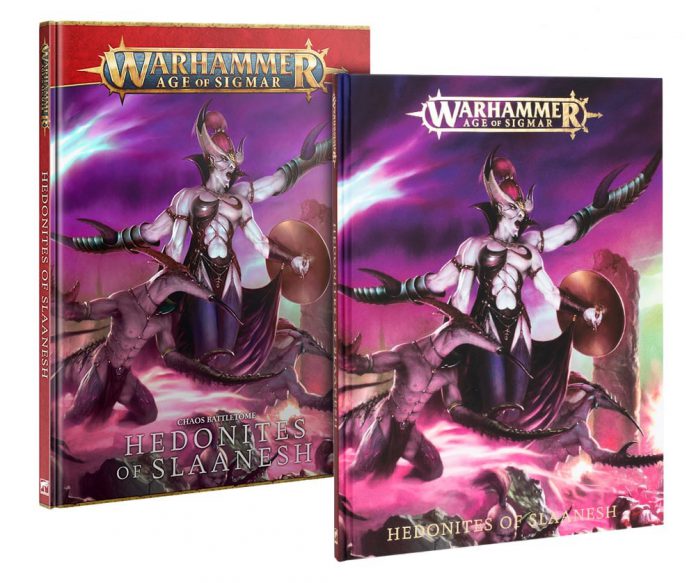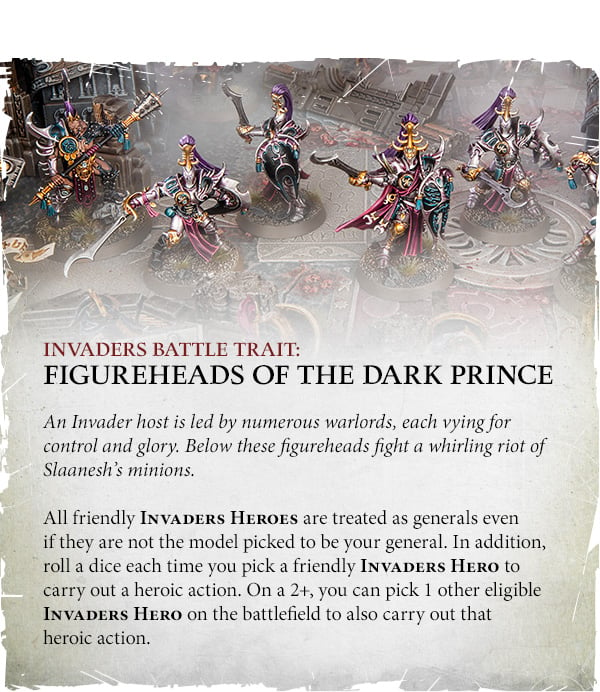This review was completed with a free copy of Battletome: Hedonites of Slaanesh, provided to us by Games Workshop
This weekend sees the arrival of not just one Chaos tome, but two. Alongside our review of Blades of Khorne we have the excessive, the exotic and the exclusive Hedonites of Slaanesh (okay it’s not that exclusive…). Last time we covered this army they sported a new expanded mortal range, though a lot of their potency left something to be desired. After some time Games Workshop are back with a revamped and altogether thematic slam dunk of a book.
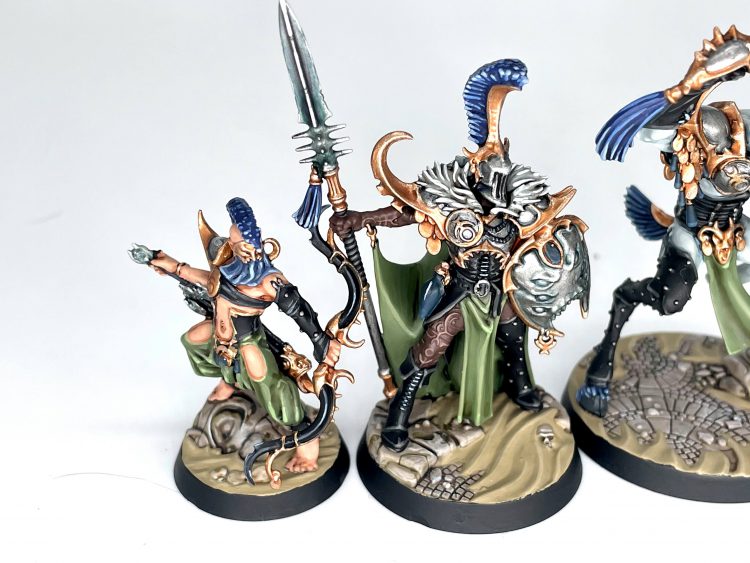
Why play Hedonites of Slaanesh?
Let’s split this into three answers, one thematic, one mechanical and one hobby oriented. Slaanesh lets you feel like a vile temptress, offering your opponent hard bargains that always leave them feeling like they made the wrong choice. Play Slaanesh if you want to feel very flexible and bring pain upon your enemies in cruel and unusual ways. Mechanically, Slaanesh are able to play in all phases of the game pretty well, and they also offer the versatility of reliable summoning which helps ensure you are able to play all five rounds effectively. You’re easily one of the fastest armies in the game, with 14” move and run and charge peppered throughout this book.
Finally, a large portion of the range is in modern plastic, with the mortal section in particular seeing a lot of love a few years back – with a few notable exceptions the range is gorgeous and you don’t have to worry about working with finecast or resin at all.
Top 5 Things about the Battletome:
- Depravity has been reworked and is a lot more thematic and consistent: Gone is the need to edge your opponent’s units and never actually kill anything. We’ll dive into the mechanics a little further down as it deserves it’s own section but it’s rad as hell.
- Three very potent subfactions that are more developed than most: Each of the three subfactions you can pick have their own battle traits, command traits, artefacts and their own spell lore. More to the point, all three feel strong – one edges out the others but there’s no clunker.
- Centerpiece models see a big lift: The Keeper of Secrets and Glutos are both a more compelling choice, being tougher and more useful than their previous incarnations.
- Some of the best debuffs in the Game: Things like shutting off command ability use, movement or attacks reduction, handing out -save penalties… the list goes on.
- Three very good unlockable army wide buffs: As you generate depravity you can unlock -1 to hit your stuff, mortal wounds on 6s to hit in addition for melee, and finally a 5+ ward.
The Rules
Battle Traits
So let’s give a quick overview before we dive into specifics – exploding 6s to hit are gone and depravity has been redesigned but still functions as both a banked resource that unlocks passive buffs, or can be cashed in for summoning a unit of daemons. In addition, the ability for daemons to potentially shut off pile-ins is gone, as are the Hosts of Chaos from Wrath of the Everchosen. They can still coalition in Slaves to Darkness and Beasts of Chaos units as they did before, with similar restrictions. All told, there’s less total battle traits here but as we’ll delve into shortly, what they have is far more effective and thematic.
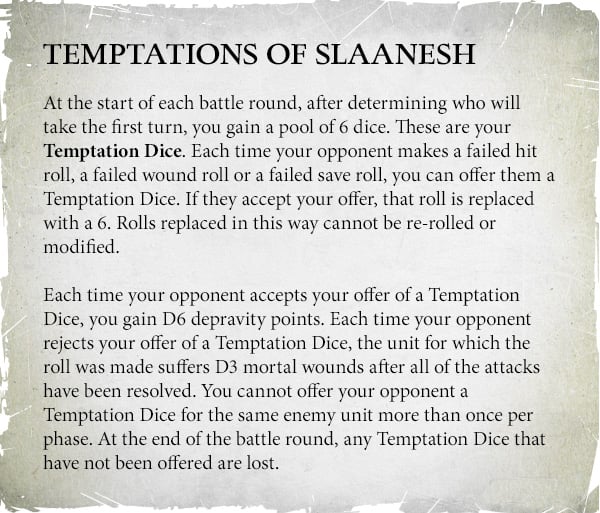
Temptations of Slaanesh
Each Battle Round, you gain 6 temptation dice to offer your opponent – every time your opponent fails a hit roll, wound roll or save roll you can offer them one of your six dice. If they accept, the dice roll gets changed to an unmodified 6 and you gain d6 depravity points, or if they refuse the temptation the unit the dice was offered to takes D3 mortal wounds. Each unit can only be offered one dice a phase but you can offer multiple dice each phase, with any leftover temptation dice lost at the end of each battle round. Note: dice swapped out this way cannot be re-rolled or modified, and the success or a failure of a hit roll is determined AFTER re-rolls or modifiers.
Hoo boy, what a thematic slam dunk this one is, as not only do you have Slaanesh’s number as your resource, but you get to offer your opponent six devil’s bargains a round that give you tangible benefits regardless of what they pick. D3 mortals doesn’t sound like much, but it adds up over the course of the game and rewards you for going after small heroes and support pieces. Your opponent won’t WANT to take the d3 mortal wounds as it might result in a dead hero who would otherwise live, but d6 depravity each time they accept the bargain means you’ll get your army wide buffs online sooner or be able to summon additional daemon units.
Euphoric Killers
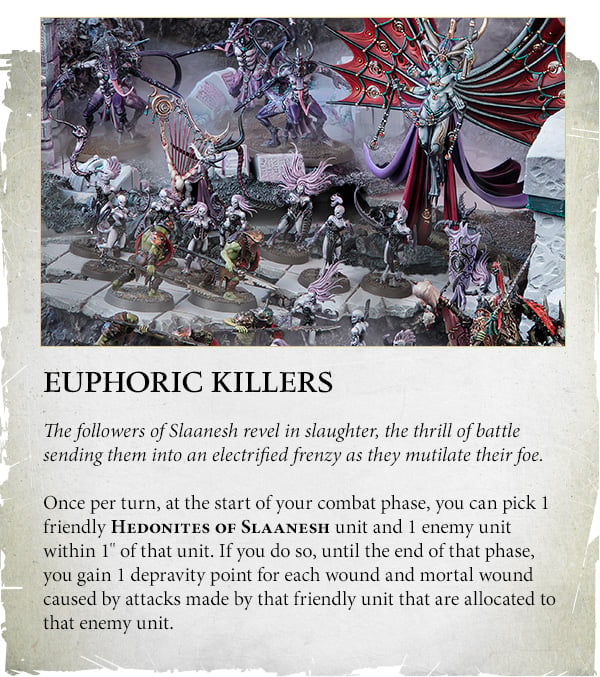
That’s not the only way you can gain depravity however, as each of your combat phases you can nominate one of your Hedonites of Slaanesh units and one of your opponent’s units within 1” of that unit. Until the end of the phase, you gain 1 depravity for each mortal wound and wound caused by attacks made by the Hedonite unit that are allocated to the enemy unit.
What this means in practice is that you could potentially earn up to 10 Depravity if you’re fighting against a typical 10 wound MSU unit if you’re able to completely destroy them, but it gets very wild very quickly if your opponent has a large wound count unit and you have a powerful enough melee threat to do that much damage. The metagame at the moment has shifted towards large hammer units that can take and hold the middle, which means the Hedonites can really cash in if they can leverage their buffs and debuffs to get a key combat situation to really revel in the glory of battle.
Revel in Depravity
Speaking of reveling, let’s talk about what all those depravity points get you, with the first being these abilities you have depending on the number of DP you currently have. Each effect is cumulative:
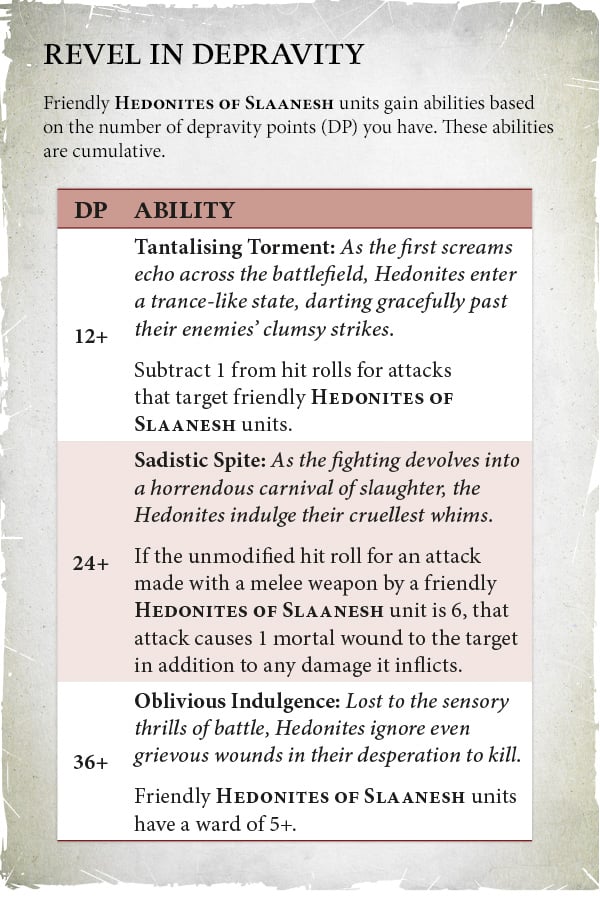 All three are very strong, and apply to all Hedonites of Slaanesh units regardless of whether they are Mortal or Daemon. The real accelerant occurs when you hit 24 Depravity, as those mortal wounds combo well with Euphoric Killers to up every one of your unit’s damage ceiling, meaning more depravity which means you hit the army wide 5+ ward quicker and oh my gosh are we playing Nurgle or Slaanesh here?
All three are very strong, and apply to all Hedonites of Slaanesh units regardless of whether they are Mortal or Daemon. The real accelerant occurs when you hit 24 Depravity, as those mortal wounds combo well with Euphoric Killers to up every one of your unit’s damage ceiling, meaning more depravity which means you hit the army wide 5+ ward quicker and oh my gosh are we playing Nurgle or Slaanesh here?
Summon Slaaneshi Daemons
This returns from the previous book with some adjustments – everything is more expensive (roughly 3* as much) to summon, as Depravity is easier to generate than previously, and notably you can only ever summon 10 Daemonettes at a time, gone ia the ability to summon big blocks of the crab ladies. Some units have shuffled up in relative cost (like Fiends) as a result of their warscroll seeing a significant upgrade, but with the Revel in Depravity buffs being as good as they are I personally believe you’ll likely bank the points and just spend any excess over 24-36 (depending on need) to bring in a clutch Keeper of Secrets, Contorted Epitome or 10 Daemonettes to grab an objective. As before, they can be summoned wholly within 12” of a friendly HoS hero (more than 9” from enemy) or near your Fane terrain feature.
Hosts of the Dark Prince
Here’s where Slaanesh differs from their other 3rd edition siblings, as you only have three subfactions, but each have their own bespoke Battle Trait, Command Trait table, Artefact table and finally Spell lore. The net effect is that you can embrace a different playstyle with a change in Host to an extent that isn’t really possible with other books, as their changes typically just change battleline options and give you a token bonus effect, this is more extensive as a trade off for having fewer options.
Invaders

First up are Invaders, which offer a balance between debuffs and buffs, while also giving your HoS heroes a boost.
Figureheads of the Dark Prince
All friendly Invader heroes are treated as generals, even if they were not picked to be your general. Notably unlike the previous book, they don’t have to be separated in order to issue commands, though you still only get one command trait… for now. Things don’t stop there, as when you pick an Invaders hero to carry out a heroic action, you can carry out that same heroic action on another eligible Invaders hero on a 2+ dice roll. The way it’s worded means that if you go second for the battle round in the current GHB season you don’t get to copy BOTH heroic actions (as you’re still only picking an Invaders hero once) but it’s still potent for a number of potential scenarios like double heroic recovery, or getting potentially an extra 2 CP for a turn, or even just double Finest Hour.
Escalating Havoc
Escalating Havoc has been completely rewritten and is now a heroic action, letting 1 friendly Invaders hero pick a command trait from the Invaders command trait table that that hero does not already have. That hero is considered to have that command trait until the end of the turn. Note that the way that it’s worded means that your nominated general can technically have two command traits for a turn, and as it’s a heroic action Figureheads of the Dark Prince kicks in and you could potentially copy it for a second hero… meaning potentially *three* command traits for a turn. There are some powerful combos you can pull off with this, encouraging the use of powerful combat heroes like the Keeper of Secrets to create some hellish combat monsters.
Note: There’s room for ambiguity here as to whether you could duplicate one of the Invaders command trait across two heroes, as while the wording doesn’t forbid it; it’s vague enough that it likely warrants an FAQ. This review will assume it’s not possible, but if it’s allowed then Hurler of Obscenities becomes… insane.
Invaders Command Traits
- Best of the Best – The general adds 1 to the attacks characteristic of their melee weapons if they’re within 6” of a different hero (enemy or friendly). Solid and a worthy grab if your Keeper of Secrets is going to wade into combat this turn.
- Glory Hog – At the end of the combat phase if the general is still alive and you destroyed an enemy unit that phase, gain 1 command point. This is mostly unexciting and you’ll never take it as your main command trait, but if you’re going first in the battle round and expect to need more CP for their turn you might grab this with Escalating Havoc.
- Hurler of Obscenities – At the start of the combat phase, you can pick 1 enemy unit within 6” and give them +1 to hit until the end of the phase, but -1 to save rolls. Extremely powerful as a means to give your army effectively extra rend against key targets, and the downside of +1 to hit is a fine tradeoff.
Of the three, Hurler is probably going to be the most broadly useful and one you always have on your general, with Best of the Best being grabbed in certain situations.
Invaders Artefacts
- The Rod of Misrule – Keep track of the number of 6s you roll for hit and wound rolls by this bearer each turn – at the end of the turn if that number is 6 or more and the bearer is still on the battlefield, gain 1 depravity point. It’s a bit pants when you’re typically grabbing depravity 1-6 points at a time, so you’ll skip this.
- Icon of Infinite Excess – Sleek and simple, once per battle at the beginning of the combat phase you can use this icon to grant all friendly HoS units +1 attacks to their melee weapons until the end of the phase.
- The Beguiling Gem – At the start of the combat phase, pick 1 enemy Hero in combat with the bearer and roll 3D6 – if you beat that Hero’s bravery characteristic, subtract one from attacks characteristic of their melee weapons until the end of the phase.
You’ll likely only be interested in Icon here, as the other two are pretty niche and are beaten out by generic options like the arcane tome or gryph-feather charm.
Invaders Spells
- Lash of Slaanesh (CV 6), range 12” – Pick an enemy unit within range and visible, roll dice equal to the number of models in that unit. For each 5+, subtract 1 from their attacks characteristic (to minimum of 1) until your next hero phase. Incredibly powerful spell if short range that will absolutely cripple all but the most elite hammers and heroes.
- Pavane of Slaanesh (CV 6), range 12” – Pick an enemy unit within range and visible, roll dice equal to their move characteristic, for each 5+ subtract 1 from their move characteristic (to minimum of 1) until the end of the battle. The same unit cannot be affected by this spell more than once. Potentially very potent but it’s short range means unless you’re using spell portal to extend its range it’s number of useful scenarios is rather limited.
- Hysterical Frenzy (CV 7), range 18” – Pick an enemy unit within range and visible, roll dice equal to their bravery characteristic. For each 6+, the enemy unit takes D3 mortal wounds. Ends up being pants against low bravery units but can potentially spike quite a bit of damage against high bravery units like Daemons or the Undead.
Of these, Lash is the standout favourite, with the other two being taken if you’re not interested in Flaming Weapon or you have a specific use case in mind.
Pretenders
Pretenders may take the crown for the most powerful subfaction I’ve seen since Thunder Lizards for the Seraphon. Unless you have a very specific reason to take one of the other two factions you’ll be in Pretenders, as they offer fantastic value. I’m usually not one for strong statements but I think we’ll be seeing Pretender Slaanesh armies competing for podium finishes at tournaments for the foreseeable, let me tell you why!
Heir to the Throne
If the model picked to be your general is on the battlefield at the beginning of the hero phase, you gain 3 command points instead of 1. That means if you go first you’ll end up with 4 and then another 3 for a total of 7 for the battle round, and if you go second you end up with 8 overall. Extremely powerful when used in concert with…
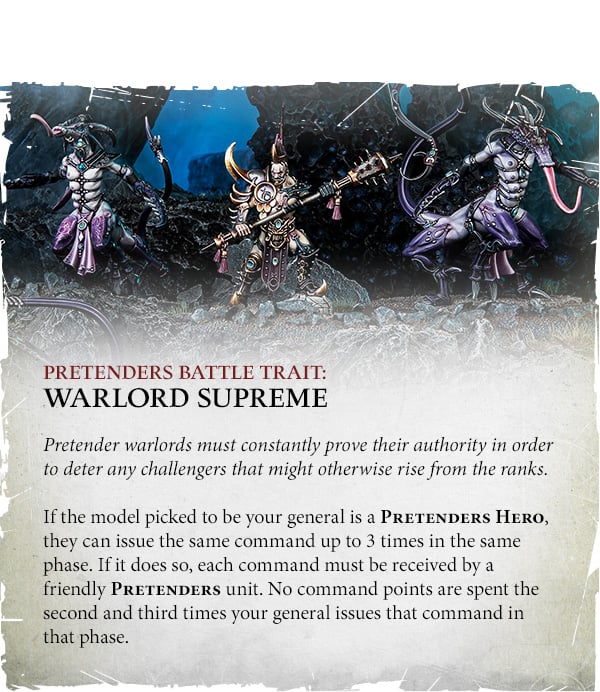
Warlord Supreme
If the model picked to be your general is a Pretenders hero, they can issue the same command 3 times in the same phase, with the standard restrictions that the same unit cannot receive the command multiple times. The second and third times don’t require a command point to be spent. For Ironjawz players you’ll be keenly aware how powerful this is, and it gets especially powerful in an army that has access to a very respectable shooting contingent for potential triple unleash hell madness. We’ve been testing this in internal games and it’s about as powerful as you can expect, as you have so many command points you can basically just do everything like auto run 3 units 6” (as many of them have run and charge), rally anything that’s even been tickled lightly and so on. Note that you still need to be in range to issue the command, which as a general can issue 18” away is still a pretty large area, but it’s also a strong incentive to bring a Keeper of Secrets as your general to take advantage of their large base size.
Pretenders Command Traits
- Strongest Alone – Add 1 to all hit and wound rolls for this general if they’re more than 6” away from all other friendly units. There are better ways to access +1 to wound in this book so safely skippable.
- Monarch of Lies – Each time an enemy unit receives a command within 6” of this general roll a dice, on a 5+ the command is not received (it still counts as having been used) and the CP used is considered to have been spent. Solid and can potentially ruin your opponent’s day, if somewhat unreliable.
- Strength of Godhood – Here we go. If this general issues a command to a different friendly Pretenders HoS unit, until the end of the turn add 1 to the Rend and Damage of their melee weapons. Note that because of Warlord Supreme this is something you are going to be doing all of the freaking time, and it can make a Keeper of Secrets into an absolute daemon in combat.
If you’re taking a Keeper of Secrets you are likely grabbing Strength of Godhood, with Monarch of Lies or Master of Magic being your other considerations if not.
Pretenders Artefacts
- The Crown of Dark Secrets – At the start of your first hero phase, pick 1 enemy unit. For the rest of the battle, the unit’s attacks characteristic of all their melee weapons is 1 if they’re within 6” of the bearer. Very powerful if you can make sure your general is in position and your opponent has one particularly powerful combat unit they want to leverage.
- Sceptre of Domination – At the start of the combat phase, roll a dice for each enemy unit in combat with the bearer. On a 5+, the strikes-last effect applies to that unit until the end of the phase. Somewhat unreliable but very powerful both offensively and defensively.
- Breathtaker – Pick 1 of the bearer’s melee weapons, if said weapon slays an enemy model, all effects that would be triggered by that model’s death are ignored. Certain armies will absolutely hate this but it’s a niche artefact that you won’t bring outside of casual games.
It takes a lot for an artefact to be better than Arcane Tome, but both the Crown and Sceptre are at least worth considering, with their inclusion more likely if you’re bringing a Warlord or Command Entourage battalion for an extra enhancement.
Pretenders Spells
- Soulslice Shards (CV 5), range 12” – Pick an enemy unit within range and visible. Roll 2d6 and if you beat their bravery characteristic that unit cannot issue or receive commands until the beginning of your next hero phase. Extremely powerful and flexible spell you will always bring.
- Phantasmagoria (CV5), range 12” – Pick an enemy unit within range and visible. Until your next hero phase, each time said unit is picked to fight, you may pick a friendly HoS unit within 3” of that unit, that friendly unit can retreat. An absolutely wild spell that you will always bring (deja vu?). To elaborate, on offence you can pick a unit you fear you won’t destroy and tag it with this spell, charge it with exactly one of your units, fight with it and then when your opponent activates you can retreat back to safety. Defensively, it lets you protect one unit from your opponent each time their debuffed unit charges your lines. It’s potency is mitigated somewhat if there are multiple units within 3” of the unit, but it lets you always retreat with the unit you’re most worried about losing.
- Born of Damnation (CV6) – Roll 6 dice, for each 4+ add a depravity point. Less glamorous than the other two but is always going to be useful and you will always want to cast it.
As you can see, all three are very good and as such will either encourage you to bring 3 spellcasting capable heroes so you can cast all three, or bring arcane tome to make a random support hero into a wizard for better access.
Godseekers
This subfaction is all about the need for speed, with a variety of enhancements to your mobility, as well as tools to dictate the activation wars more effectively than your opponent.
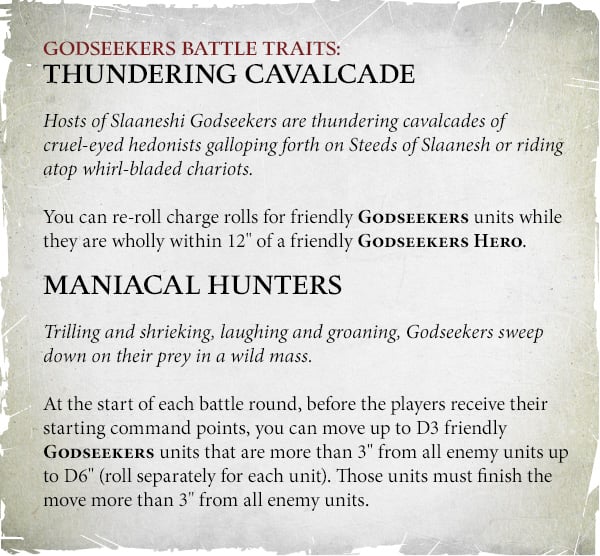
Thundering Calvacade
You can re-roll charge rolls for friendly Godseekers units while they are wholly within 12” of a friendly Godseekers hero. Simple and effective for a battle trait but a nevertheless potent ability to help the army consistently get into combat.
Maniacal Hunters
At the start of each battle round before the players receive their starting command points, you can move up to D3 friendly Godseekers units that are more than 3” from any enemy up to d6” (roll separately for each). Those units must finish the move more than 3” from all enemy units. This is a rather inconspicuous ability that is nevertheless very powerful as both an objective control ability as well as a means to further increase the mobility of the army’s already stupendous movement.
Godseekers Command Traits
- Into the Fray – Strike-first effect for the general if they made a charge move in the same turn. Very strong if you’re able to pair it with a secondary powerful unit to effectively double dip in combat activations. Fun little synergy with the Keeper of Secrets’ once per game fight twice granting ability as they would cancel out and said general could theoretically fight twice.
- Speed-chaser – Essentially the Ogor Mawtribes monster charge, you roll dice equal to the charge roll when making a successful charge with the general and for each 4+ deal a mortal wound to an enemy unit within 1”. Very good if you have access to 3d6 charges, either via an allied Warshrine or… well you’ll see.
- Hunter Supreme (Monster only) – enemy units within 3” cannot make pile-in moves if this general made a charge move in the same turn, and add 1 to the general’s attacks characteristic for melee weapons if they made a charge move that turn. It’ll make it very hard for anyone to stop a Keeper of Secrets on the turn they charge, and make them significantly more threatening due to their high quality weapons.
Godseekers Artefacts
- Cameo of the Dark Prince – Once per battle at the start of the hero phase the bearer can use this to allow them to issue commands to friendly Hedonites units without any command points being spent until the end of that turn. Getting maximum value out of this you could issue 6 commands in a turn which IS pretty nice, but more likely you’ll get 2 or 3 and I’m not sure it’s worth it compared to other options.
- Threnody Voicebox – Once per battle at the start of the combat phase the bearer can activate it to subtract 1 from the Attacks characteristic of enemy units within 6” of the bearer to a minimum of one. Now this is a powerful defensive effect in a world where Slaves to Darkness and Gitz are throwing around massive melee hammer units. There aren’t too many ways to improve Slaanesh’s durability and this is worth consideration depending on your local metagame.
- Girdle of the Realm-racer – The bearer can fly and activate and pile in within 6” of enemy units instead of 3” and move an additional 3” when they pile in. This effect is obviously very strong for something like a Keeper of Secrets, especially when you combine this with Maniacal Hunters to sneak it into position on your opponent’s turn and they don’t notice.
Godseekers Spells
- Paths of the Dark Prince (CV5) – If successfully cast the caster can charge 3D6” until your next hero phase. Notably it does NOT mean they can declare a charge within 18” instead of 12”, so while powerful it’s limit to only affecting the caster and the rather subdued version of it means it’s probably at it’s best if you’re gearing up your general with Speed-chaser.
- Progeny of Damnation (CV5), range 12” – If successfully cast pick 1 friendly Hedonites unit within range and visible and until your next hero phase that unit moving within 9” of an enemy unit does not allow said unit to use the Redeploy command. Strong but situational.
- Slothful Stupor (CV7), range 12” – If successfully cast, pick 1 enemy unit within range and visible. Until your next hero phase their movement is 3” and all run and charge rolls for that unit are treated as being 3. Stupidly powerful ability that completely neuters a combat unit if utilised smartly, though its inconsistent casting value of 7 means you’ll likely want a Contorted Epitome to cast it.
Grand Strategies

A few decent options here which are nice in the long term when this season’s offerings rotate or as simple straight up placements if you want to tailor your playstyle to them.
- Coveted Riches – Destroy all your opponent’s units that have artefacts of power and have at least 1 friendly unit alive with an artefact. A reasonable consideration but likely a side-grade from the season’s current offerings.
- Arch-tempter – Offer a temptation dice to the same enemy unit 6 or more times during a battle. Absolutely awful as the chances of your opponent even having a unit alive for all five battle rounds AND be in a situation where you can even offer these dice to them consistently enough is awful, especially as it means you can’t actually kill the unit you’re trying to score this on early or you’ll fail your grand strategy.
- Selfish Desire – Never summon any Daemons during the battle. Simple and effective, with the scaling buffs meaning there’s a very consistent pathway to scoring this as you can just play the army as if it didn’t have summoning and effectively guarantee this.
- Glutton for Depravity – Complete this grand strategy if you have 36 or more unspent depravity points. Weirdly this is probably strictly better than Selfish Desire unless you don’t think your army is going to consistently get to 36 depravity points… which is technically possible if your army doesn’t have any real melee hammer units to help generate extra outside of Temptation Dice.
Battle Tactics
A section that can dictate the ceiling of a faction’s competitive viability, as a good selection of alternatives gives them a great deal of flexibility in gameplan on a game by game basis. The good news for followers of Slaanesh is that this set is rock solid with some baseline ‘good’ picks and a few solid niche options too.
- Death by a Thousand Cuts – Pick 1 enemy unit and have 3 different friendly units allocate wounds to it during this turn. Probably the best of the bunch here if you’re using Blissbarb archers (and you probably will) and will be picked often.
- An Enrapturing Blur – Pick an enemy hero with 0 wounds allocated to it and destroy it in the combat phase before it is picked to fight. Very situational but very achievable when applicable.
- The Grand Feast – Gain 12 or more depravity points from the Euphoric Killers battle trait this turn. Perfect for games where your opponent has a unit that is effectively a big bag of wounds (like say a large squig herd unit or some Orruks).
- Excessive Carnage – Pick an enemy unit contesting an objective and destroy it this turn with the unit you picked to use the Euphoric Killers battle trait this turn. A few hoops to jump through here as you don’t want to kill the unit before combat AND you’re likely giving up a higher ceiling in depravity points potential if you’re smartly picking a unit easily destroyed. E.g. picking a 5 wound foot hero and capping out at 5 depravity versus picking a 20 wound combat unit you might not be guaranteed to destroy.
- Realm-racers – Make a charge move of 7” or more with 3 differently Hedonites units this turn. Probably never picking this unless you’ve got access to widespread charge rerolls, but nice in a pinch.
- Depraved Unity – Pick an objective you don’t control and control it at the end of the turn with at least 1 daemon and 1 mortal Hedonite unit at the end of the turn. Another fantastic and relatively safe choice in situations where you’re confident of taking an objective back and you have the relevant keyword forces nearby.
Next up: The Units
The changes in this battletome have gotten pretty long, so we’re gonna break this up into two parts. The Units will be coming shortly so stay tuned!
